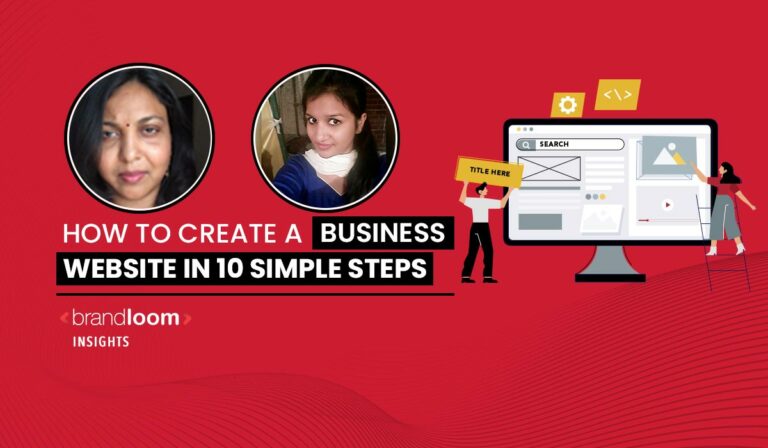In today’s digital age, having a strong online presence is more important than ever for businesses. Nothing can be more powerful than creating a business website today. As a small business owner, you must know How to Create a Business Website.
Why?
A great website is essential for the success of any small business, whether you are a freelance photographer, own a hardware store, or run another type of small business.
97% of consumers use the internet to search for products or services, and 94% of first impressions are related to a website’s design.
However, a shocking 36% of small businesses still don’t have a website, which can severely limit their growth potential.
If you’re one of those businesses, don’t worry.
Importance of Website in Business
Your business website is your digital storefront and can be a powerful marketing tool to attract and retain customers.
It can also help you establish credibility and build trust with potential clients.
According to a survey by Clutch, 29% of small businesses cited increased credibility as the main reason for having a website.
Furthermore, having a website can increase revenue, with 64% of small businesses reporting a positive impact on their revenue after establishing an online presence.
But where do you start? With so many website builders and platforms available, creating a website can be daunting, especially if you’re not tech-savvy.
if you want to learn how to make a business website, read on.
Essential Requirements in Designing Good Business Website
Designing a good business website is essential for any company looking to establish a strong online presence and attract customers.
However, creating a website that stands out from the competition requires more than a visually appealing design.
Here are some essential requirements that can help you create a website that drives results:
- Clear and Concise Messaging: Your website should communicate your brand’s messaging and value proposition concisely and easily. This includes having a clear headline, well-written copy, and compelling visuals.
- User-Friendly Navigation: Your website should be easy to navigate, with a logical and intuitive structure that allows users to find what they’re looking for quickly and easily.
- Mobile-Friendly Design: With more and more users accessing the internet on mobile devices, it’s essential that your website is designed with mobile in mind. This includes having a responsive design that adapts to different screen sizes and ensuring that your website is easy to use on smaller screens.
- Search Engine Optimization (SEO): A good business website should be optimized for search engines with relevant keywords, meta tags, and optimized content that can help improve your search engine rankings.
- Trust Indicators: Including trust indicators such as customer reviews, security badges, and professional associations can help build trust with potential customers and increase conversion rates.
By incorporating these essential requirements into your website design, you can create a website that looks great and drives results for your business.
Best Business Website Examples
Here are five examples of great business websites that showcase different design approaches and features:
1 Apple:
The Apple website is a great minimalist design emphasizing product imagery and user experience.
The website features clean typography, large product images, and simple navigation that showcases Apple products and the brand.
2 Airbnb:
The Airbnb website is designed to appeal to both hosts and travellers.
The website features clear messaging, a streamlined sign-up process, and detailed property listings that help users find the perfect place to stay.
3 Slack:
The Slack website is designed with a focus on user experience, featuring simple, bold graphics and clear messaging that communicates the product’s value.
The website also features a comprehensive FAQ section and a detailed pricing page that helps users understand the product and its pricing.
4 Patagonia:
The Patagonia website is designed to appeal to environmentally conscious consumers, focusing on sustainability and social responsibility.
The website features powerful imagery, detailed product information, and a blog that showcases the company’s commitment to environmental and social issues.
5 Mailchimp:
The Mailchimp website is designed to appeal to small businesses, focusing on usability and features that help businesses grow their audience.
The website features clear messaging, easy-to-use navigation, and many resources, including marketing tips and case studies.
These are just a few great business websites showcasing different design approaches and features. When designing your own business website, it’s important to consider your target audience and what features and design elements will best appeal to them.
If you want to get inspired by the above and want to know How to Create a Business Website, read on!
Benefits of a website for business:
Here are some of the key benefits of a website for business:
- Reach a Wider Audience: A website provides a global platform for your business, allowing you to reach a wider audience than traditional marketing methods.
- Increased Credibility: A professional website can increase your business’s credibility and legitimacy, making it more attractive to potential customers and partners.
- 24/7 Availability: Unlike a physical store, a website is available to potential customers 24/7, allowing them to learn about your products and services anytime.
- Cost-Effective Marketing: A website is a cost-effective marketing tool that can reach more people than traditional advertising methods, such as print or TV.
- Improved Customer Engagement: A website can improve customer engagement by providing a platform for communication, feedback, and support.
- Analytics and Insights: A website can provide valuable data and insights about your customers, such as demographics, preferences, and behaviour.
- Competitive Advantage: A professional website can give your business a competitive advantage, helping you stand out and attract more customers.
By understanding the benefits of a website for business, you can create a strong online presence that helps you achieve your business goals and grow your customer base. Read on if you want to know How to Create a business website.
How to Create a Business Website in 10 Simple Steps:
In this article, we’ll break down the process of creating a business website into 10 simple steps, so you can join the 64% of small businesses that do have a website and start reaping the benefits of a strong online presence. Here is How to Create a Business Website in 10 Simple Steps:
1. Purchase a suitable domain name
The point of entry to your website is frequently your domain name, also known as your website address. It is critical for both usability and search engine optimization that it makes a good first impression (SEO).
Here are some ideas for creating a perfect domain name:
- Make it easy to spell. Slang, made-up, or extremely esoteric words should be avoided.
- Keep it as short as possible. Shorter words are easier to remember and type correctly.
- Use the appropriate domain extension. Unless another extension, such as.gov,.edu, or.org, is more appropriate, always use the a.com domain name (rather than. net,.co, etc.).
- Avoid names that are out of context. Choose a name that conveys meaning so users can understand your company immediately. Although Yahoo and Google have memorable names, branding them is costly, and your small business may not have the same budget.
- Create a URL that is SEO-friendly. Create an SEO-friendly website address that includes keywords and geolocation.
2. Purchase a dependable, scalable website hosting service with excellent technical support.
A website host is a company that offers the technology and services needed to view a website online.
Users are directed to your host when they click on your website address.
Hosting services can range from $2 to $100+ per month, depending on the technology and support you choose. You will usually receive a discount if you purchase a yearly plan rather than a monthly one.
Here are some suggestions for choosing a good website hosting plan:
2.1 Shared Servers
While it is possible to obtain a “shared server” hosting plan for $2 per month, it is generally not advisable.
Shared hosting involves sharing a server and its resources with other customers, which can negatively impact site performance.
In addition, if one of the other websites on your shared server is compromised, your website may also become infected.
2.2 Dedicated Servers
The most expensive option is a “dedicated server” hosting plan (prices range from $100 to $2,000 per month), but it will ensure your website performs optimally.
A dedicated server plan is a physical machine entirely dedicated to your website; as a result, all of the resources belong to you. It is safer than a shared hosting plan if the technology stays current.
It is, however, far more expensive than most small businesses are willing to pay. This may be necessary if you have a high-performing website, but it is unnecessary for most early-stage and small businesses.
2.3 Virtual Private Servers (VPS)
The typical compromise I recommend is a “virtual private server” (VPS) hosting plan that provides the best of both worlds.
The monthly fees range between $20 and $50, which is reasonable for the hosting services provided.
A virtual private server (VPS) is a single machine that has been partitioned to act as multiple machines, giving it the affordability of shared hosting while having the security and performance potential of a dedicated server hosting plan.
2.4 Cloud Hosting
Well, here is my preferred solution. Yes, when it comes to web hosting, businesses have several options, including shared hosting, Virtual Private Servers (VPS), and dedicated servers.
While shared hosting is the most affordable option, and VPS provides a dedicated server-like environment, the fourth option – cloud hosting offers unmatched scalability, flexibility, and reliability.
Cloud hosting involves hosting websites on a virtual server network, allowing for quick resource allocation and easy scaling up or down based on changing needs.
Additionally, cloud hosting ensures uptime and fast loading times, making it an ideal choice for businesses that prioritize performance and user experience.
Overall, cloud hosting offers the best balance of cost, performance, and reliability for businesses of all sizes.
Other Tips on Hosting
Also, Confirm
Confirm that your hosting company offers phone and/or chat support so that you can get help quickly if a problem arises.
When a problem needs to be resolved quickly, email support can often be inconvenient and frustrating. Although phone support is preferred, chatting works just as well.
To access your server, you must have an easy-to-use server interface, such as cPanel. You don’t want to use terminal commands to view and change the contents of your server unless you can afford to hire a professional server administrator.
Determine what kind of server security is on the server you’re considering purchasing.
You must be able to connect to your server through Secure File Transfer Protocol (SFTP). The contents of your server should be backed up daily.
Installing Secure Sockets Layer (SSL) certificates should be as easy as one or two clicks. Check to see if the hosting company conducts regular security checks. Your hosting provider should ideally have a security policy in place.
3. Use the most effective content management system available.
A content management system (CMS) is software that enables the creation and management of digital content.
A good CMS will assist you in site maintenance and requires little technical knowledge to use.
It would help to choose a CMS tailored to your specific needs; different systems are used for various reasons, including user-friendliness, extensibility, and cost.
The following are are the most popular CMS, along with their strengths and weaknesses:
3.1 WordPress
WordPress is the world’s most renowned content management system (CMS).
It has a large, active support community and a plethora of useful plugins to help you extend your site’s functionality.
(If you can’t find a plugin that meets your requirements, you can always hire a WordPress developer to create one for you!)
WordPress is also free and simple to set up. Almost all website developers are familiar with it, so finding a person or company to work on your site should be simple.
Small businesses should use WordPress to create their websites because of its flexibility and extensibility.
It should be noted, however, that WordPress’s main weakness is security—due to its popularity, hackers target it the most.
Your WordPress site must be regularly maintained and secured to avoid being hacked.
Furthermore, because it is difficult to secure every third-party plugin, maintaining the security of your WordPress site must be a continuous commitment via various best practices (checking if your plugins have been updated within the past few months, being sure of a plugin provided in the official WordPress repository, deleting unused plugins instantly, etc.).
3.2 Drupal
Drupal is yet another well-known CMS.
It shares many of WordPress’s advantages, such as flexibility, simplicity, and a large support community.
It is more secure than WordPress (less vulnerable to malicious activity) but lacks as many plugin or theme options, making it less extensible.
For several years, the White House website (Whitehouse.gov) was powered by Drupal before switching to WordPress, which it still uses today.
3.3 Joomla
Joomla! : Another popular CMS is Joomla! It owns better SEO, security, and multilingual capabilities out of the box than WordPress; however, WordPress outperforms Joomla’s capabilities with the help of a few plugins.
3.4 Squarespace:
Squarespace is a monthly or annual subscription service that makes creating a website or blogs a simple “drag and drop” experience.
Business website design, development, software maintenance, metrics, a domain name with annual purchase, SSL security, 24/7 support, and unlimited bandwidth and storage hosting are all included in the all-inclusive package.
It is ideal for designers because it comes with high-quality design templates. This is an excellent service if you are on a tight budget and need a simple and beautiful website but cannot afford a website designer.
Squarespace has a much lower learning curve than WordPress, Drupal, and Joomla!, but it lacks a plethora of extensibility options.
Squarespace, on the other hand, is one of the finest preferences if you have little or no technical knowledge and want a quick and easy way to create a website.
3.5 Wix:
Wix is similar to Squarespace, but it is simpler to use.
It offers a monthly subscription but no annual subscription, as well as similar features.
Wix, like Squarespace, is a drag-and-drop builder that allows you to freely drag and drop elements anywhere on the page, whereas Wix is more structured where you can drag and drop elements on the page.
Wix has a lower learning curve than Squarespace, so it may be your best option if you need to publish a site quickly.
Wix has many more templates than Squarespace, but once you’ve decided on one, you must stick with it or be forced to rebuild your site entirely.
Squarespace allows you to change your template at any time without having to rebuild the entire site.
3.6 How to make a small business website for free
You can make a business website for free with the following Sure, here’s a list of some popular free small business website builders:
- Wix – Offers a drag-and-drop website builder with customizable templates and a free plan with limited storage and bandwidth.
- Weebly – Provides an easy-to-use drag-and-drop editor, customizable templates, and a free plan with limited storage and Weebly branding.
- WordPress.com – Offers a free plan with basic features, including a subdomain and limited storage, but additional functionality and features are available with paid plans.
- Google Sites – A simple website builder that integrates with other Google tools, such as Google Drive, with a free plan offering basic features and a subdomain.
- Jimdo – Provides a free plan with a customizable website builder and limited storage and features.
- Webnode – Offers a drag-and-drop website builder with customizable templates and a free plan with basic features and limited storage.
- SITE123 – Provides a user-friendly website builder with customizable templates and a free plan with basic features, including a subdomain and limited storage.
- Strikingly – Offers a simple website builder with customizable templates and a free plan with limited features and Strikingly branding.
- Carrd – Provides a free plan with a simple website builder, customizable templates, and basic features, including a subdomain and limited storage.
- Zyro – Offers a drag-and-drop website builder with customizable templates and a free plan with basic features, including a subdomain and limited storage.
4. A clear description of your company should be prominently displayed.
It’s critical to immediately make people aware of your capability and expertise so they don’t get confused when visiting your small business website.
Make your main homepage banner (also known as a “hero image”) and subsequent banners visual representations of your services, and include a text blurb near the top of the page flexing your muscle in the concerned field.
Furthermore, ensure that “About Us” page links are easily accessible in both your main and footer navigation menus so visitors can click them and learn more about your company.
5. Keep your pages clutter-free.
According to Paul Bolls, associate professor of strategic communication at the Missouri School of Journalism, readers must be able to contextualize information.
When a website contains excessive information, the mind becomes overburdened and incapable of retaining new information.
Use a good balance of text and graphics to create a clean page.
Remove social widgets from your site, such as a Twitter feed, to keep things simple.
Caxy Interactive CEO Michael LaVista advised asking yourself if you are adding information that your reader cares about.
Remove any widget content that does not serve the purpose of the page.
6. Verify that all the information is correct.
Customers will be turned off by inaccurate information, whether a wrong number, outdated product information, or simple grammatical errors.
You should proofread each page before publishing it. Moreover, you should check it regularly, too, particularly after making changes elsewhere.
7. Incorporate a call to action.
Every page on your website should encourage visitors to take action. In other words, you must issue a summons to them.
These landing pages should entice users to take a specific action, such as calling your company, signing up for a service, purchasing a product, downloading a whitepaper, or doing something else that advances your company’s goals.
Give them a clear call to action, such as a button, a link, or language. Keep it above the fold if possible. So that readers do not have to scroll to find the call to action.
8. Maintain as much simplicity as possible in your design.
Limit the use of distracting fonts, colors, and GIFs that can draw the viewer’s attention away from the page’s main focus.
Short paragraphs and bullet points make scanning and reading the information easier.
Paragraphs should be no more than six lines long, according to Ian Lurie, CEO of internet marketing firm Portent Inc.
This is especially true for mobile responsiveness, which is a major factor in Google’s algorithm for ranking websites.
The higher a website’s ranking, the higher it appears on the search engine results page (SERP).
If a competitor’s website is mobile-friendly, but yours isn’t, you may be pushed down in search results for your customers.
Work with Brandloom’s UI UX design team to create an impressive web page for your business.
9. Make it unique.
As brick-and-mortar businesses invest heavily in their storefronts to represent their brand images, e-commerce retailers must create high-quality online experiences that align with the brand’s perception.
As a result, your About Us page should be more than just a dry block of text about your company.
Include a good photo of yourself or your team to personalize the experience for your customers.
Get help from BrandLoom’s content marketing team to make unique website content to draw customers’ attention.
10. Use the best SEO practices.
You could have the best website in your industry, but it will be useless if no one can find it.
While you can pay for ads to drive prospects to your website, bringing in free organic search traffic is more cost-effective and effective in the long run.
To find information online, people use search engines, particularly Google.
They are more likely to find what they seek on the first page of search results.
So you want your company to be there. Google and other search engines rank websites based on proprietary algorithms, also known as keywords.
Search engines use three methods to determine where your listing appears: crawling, indexing, and ranking.
Crawling implies that they discovered your website through links from other websites. As a result, ensure your site’s links appear on as many external websites as possible.
When crawling bots discover your site, it is indexed, which means it is examined for content, such as keywords, freshness, relevance, links, and multimedia.
Maintain a consistent flow of new, relevant content related to the keywords you want to rank for.
Contact Brandloom’s SEO experts for your own ecommerce success.
Conclusion
If you’re about to start your own business, you’ll encounter many challenges. Starting a business is quite exciting, but many things can go south if you don’t take the right steps.
If you are looking for companies that build websites for small businesses, do not forget to contact us.
To reduce your burden and worry, Brandloom offers top-notch digital marketing services that will help your business grow rapidly.
Frequently Asked Questions
You can make a business website for free with some popular free website builders. Here is how to create a website for business for free:
Best Website Builder for Small business
Wix – Offers a drag-and-drop website builder with customizable templates and a free plan with limited storage and bandwidth.
Weebly – Provides an easy-to-use drag-and-drop editor, customizable templates, and a free plan with limited storage and Weebly branding.
WordPress.com – Offers a free plan with basic features, including a subdomain and limited storage, but additional functionality and features are available with paid plans.
Google Sites – A simple website builder that integrates with other Google tools, such as Google Drive, with a free plan offering basic features and a subdomain.
Jimdo – Provides a free plan with a customizable website builder and limited storage and features.
Webnode – Offers a drag-and-drop website builder with customizable templates and a free plan with basic features and limited storage.
SITE123 – Provides a user-friendly website builder with customizable templates and a free plan with basic features, including a subdomain and limited storage.
Strikingly – Offers a simple website builder with customizable templates and a free plan with limited features and Strikingly branding.
Carrd – Provides a free plan with a simple website builder, customizable templates, and basic features, including a subdomain and limited storage.
Zyro – Offers a drag-and-drop website builder with customizable templates and a free plan with basic features, including a subdomain and limited storage.
It’s important to remember that while free website builders may be a good option for some businesses, they often come with limitations that can impact your website’s performance and user experience.
Suppose you want more control over your site’s design and functionality or need features like a custom domain name or e-commerce functionality. In that case, you may consider investing in a paid plan or hiring a professional web developer.
While it’s possible to create a business website for free using website builders such as Wix, Weebly, and WordPress.com, it’s important to be aware of the potential limitations.
Fee website builders often come with limitations on storage and bandwidth, which can impact your website’s performance and user experience.
In addition, free plans may not include essential features like a custom domain name, SSL certificate, or e-commerce functionality.
Furthermore, in a survey by the Better Business Bureau, consumers are more likely to trust businesses with a professional website, with 84% of consumers believing that a business with a website is more credible than one without.
This highlights the importance of investing in a high-quality website that reflects your brand and builds trust with potential customers.
Therefore, weighing the potential drawbacks against the benefits of investing in a professional website builder or hiring a web developer is important.
After all, a high-quality website is an investment in your business’s success and can pay off in the long run with increased credibility, trust, and customer engagement.
A website is crucial for small businesses to succeed in today’s digital world. Here are some of the key reasons:
1. Over 80% of consumers research a business online before purchasing. Without a website, your small business could miss out on potential customers.
2. 63% of consumers use a company’s website to find and engage with businesses. This means that having a website is essential to attract and retaining customers.
3. According to a study by Clutch, nearly half of the small businesses in the US do not have a website. This presents a significant opportunity for those small businesses with a website to stand out from their competitors.
4. A website can also improve your credibility and legitimacy as a business. 75% of consumers admit to making judgments about a company’s credibility based on its website design.
5. A website can also be a powerful marketing tool, allowing you to reach a broader audience and promote your products or services more effectively. Businesses with a blog generate 126% more leads than those without one.
Without a website, you risk missing out on potential customers and losing credibility in the eyes of consumers.
Websites are an important tool for businesses to use to establish credibility and build trust with their customers. This can then be boosted further by local SEO services to attract a local demographic for businesses that are new to the market.
Yes, you can create your website for free with Wix. Wix is one of the most renowned free website builders, with over 200 million users. The user-friendly, fully-hosted platform includes a simple drag-and-drop editor, many apps, and professional-looking templates.
Wix provides everything you need to build a beautiful website, including free hosting. Upgrade to one of our Premium plans for more benefits and features. Here’s a quick look at the main differences between Premium and free sites.







